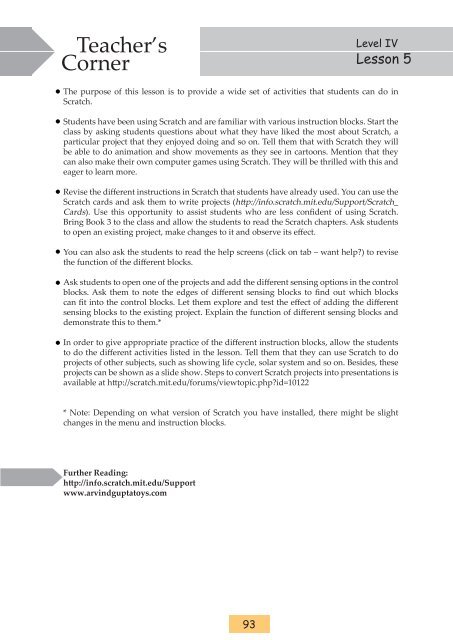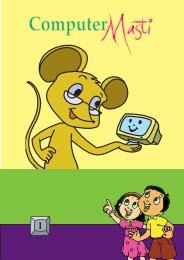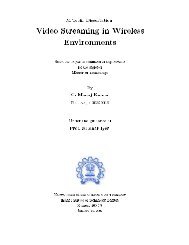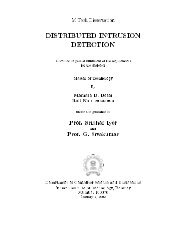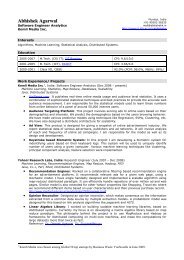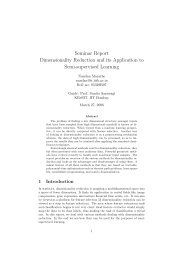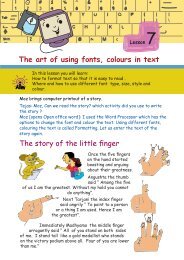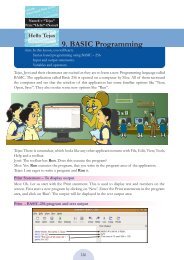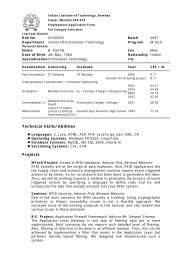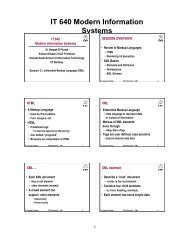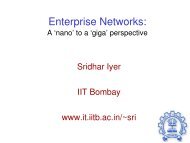worksheets - Indian Institute of Technology, Bombay
worksheets - Indian Institute of Technology, Bombay
worksheets - Indian Institute of Technology, Bombay
You also want an ePaper? Increase the reach of your titles
YUMPU automatically turns print PDFs into web optimized ePapers that Google loves.
Teacher’s<br />
Corner<br />
Level IV<br />
Lesson 5<br />
The purpose <strong>of</strong> this lesson is to provide a wide set <strong>of</strong> activities that students can do in<br />
Scratch.<br />
Students have been using Scratch and are familiar with various instruction blocks. Start the<br />
class by asking students questions about what they have liked the most about Scratch, a<br />
particular project that they enjoyed doing and so on. Tell them that with Scratch they will<br />
be able to do animation and show movements as they see in cartoons. Mention that they<br />
can also make their own computer games using Scratch. They will be thrilled with this and<br />
eager to learn more.<br />
Revise the different instructions in Scratch that students have already used. You can use the<br />
Scratch cards and ask them to write projects (http://info.scratch.mit.edu/Support/Scratch_<br />
Cards). Use this opportunity to assist students who are less confident <strong>of</strong> using Scratch.<br />
Bring Book 3 to the class and allow the students to read the Scratch chapters. Ask students<br />
to open an existing project, make changes to it and observe its effect.<br />
You can also ask the students to read the help screens (click on tab – want help?) to revise<br />
the function <strong>of</strong> the different blocks.<br />
Ask students to open one <strong>of</strong> the projects and add the different sensing options in the control<br />
blocks. Ask them to note the edges <strong>of</strong> different sensing blocks to find out which blocks<br />
can fit into the control blocks. Let them explore and test the effect <strong>of</strong> adding the different<br />
sensing blocks to the existing project. Explain the function <strong>of</strong> different sensing blocks and<br />
demonstrate this to them.*<br />
In order to give appropriate practice <strong>of</strong> the different instruction blocks, allow the students<br />
to do the different activities listed in the lesson. Tell them that they can use Scratch to do<br />
projects <strong>of</strong> other subjects, such as showing life cycle, solar system and so on. Besides, these<br />
projects can be shown as a slide show. Steps to convert Scratch projects into presentations is<br />
available at http://scratch.mit.edu/forums/viewtopic.php?id=10122<br />
* Note: Depending on what version <strong>of</strong> Scratch you have installed, there might be slight<br />
changes in the menu and instruction blocks.<br />
Further Reading:<br />
http://info.scratch.mit.edu/Support<br />
www.arvindguptatoys.com<br />
93


